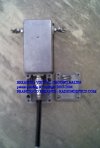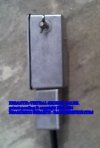 |
|
If you have a scientific interest in the physics of the
radio, you should browse this site as an e-book!
|
|
|
|
ERRANTE's BALUN
Virtual ground balun for
dipole & loop
A state-of-the-art high power
broadband HF balun
|
|
Patent n.0001347484
(ITAPA20030019) and
Patent n.0001347486
Visit the European Patent Office to see all the patents of mine
HERE
!
|
|
ERRANTE's
BALUN : what it is, how it works and how it came to be
made.
by Francesco Errante
The virtual ground balun presented hereby is the practical
application in the field of the short wave radio communications of what the
Author has previously created for scientific purposes. It, infact, along with
the virtual ground balun for doubling the ˝
wavelength folded dipole antenna, descends from the radio-electric circuitry for the suppression of
anyone of the two branches of a ˝ of wavelength open dipole.
Errante's balun is, essentially, a pure electrical transformer
which, in its most elementary layout, has a minimum of 3 tuned circuits: a
primary circuit (primary winding LC network) and 2 secondary circuits
(secondary windings LC networks).
Generally, the Errante's balun secondary circuits are identical to
each other in order to feed symmetrical balanced antennas. When necessary,
the secondary windings can be formed to have impedance values different
between each other, while maintaining the phase angle difference of the
balanced terminations to a constant ±90 degree with respect to the virtual
ground node. Moreover, as all the pure electrical transformers,
Errante's balun can be made to have more than a couple of secondary
windings.
Errante's balun is characterized for NON allowing any
impedance transformation to take place unless its terminations impedance
values are matched (NON-fluctuating impedance).
Errante's balun terminations impedance values are set by design,
hence the impedance transformation ratio is a function of them and not
viceversa, unlike it happens with any other balun arrangement. See
for example the Guanella's or the Ruthroff's
transformers which are instead characterized by having a fluctuating
terminations impedance values, as they are nothing else than an arrangement
of auto-transformers, their input and output circuits are unseparable and,
therefore, any change made to their primary circuits will inevitably affect
their secondary circuits.
In practice, a balun having a fluctuating termination impedance value carries
out its impedance transformation duty within a very ample range of impedance
values, changing its input termination impedance according to the one of its
load and viceversa. Therefore, supposed we have a Guanella's type
balun with a transformation ratio of 4:1, it will show an input impedance of
75 Ohm if its load impedance is of 300 Ohm, or it will show an input
impedance of 50 Ohm if its load impedance is of 200 Ohm. This cannot
happen if an Errante's type of balun is employed, because each
termination impedance value is a fixed property of the relevant termination
and does not vary even if there is a change in the values of the impedance of
the circuits (antennas or transmission lines) connected to them.
By limiting the line-load system impedance to the imposed values only, it is
possible to inhibit both lines and loads (antennas) from giving origins to
unwanted resonances, which are, generally, harmonic resonances, very often
deriving from the presence of more than a load on the same feed-point, which
generates alternative paths for the RF. (for example: multiple
dipoles o monopoles, fan antennas and so on). This is something not
to be underestimated, not only with regard to the transmitting phase but and
above all, to the receiving phase as well. Employing a NON-fluctuating
impedance balun, infact, introduces a very high rejection to interfering
radio signals from sources outside the bands of the radio spectrum for which
an antenna is ment. This translates in an excellent stability and selectivity
of the transmission line or antenna systems which employ Errante's
baluns.
A virtual ground balun represents the ideal device for the correct feeding of
dipole and loop antennas. The virtual ground balun carries out many functions
at once allowing to:
1) match the RF source impedance to the chosen load while introducing
neglectable insertion loss of power;
2) transform the RF signal fed to it into two identical portions with the
correct phase angle difference for the natural feeding of open or folded
dipoles and loop antennas;
3) obtain a virtual ground node for the correct polarization of its
unbalanced port;
4) obtain a common ground path for the dissipation of the charges induced by
the electrostatic phenomena;
5) obtain an high de-coupling between its two balanced ports.
The generic virtual ground balun's schematic diagram is shown here below.
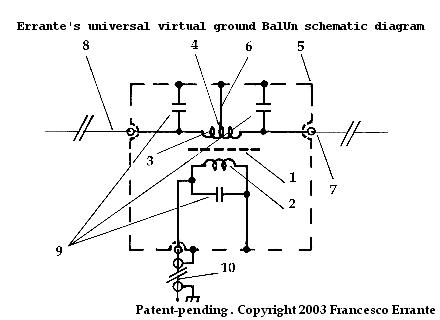
|
The virtual ground balun is housed inside a
weatherproof rugged metal enclosure having two separate compartments: one
hosts the balun circuitry while the other one protects the coaxial
connectors. The said metal enclosure not only ensures an high mechanical
robustness and a total stability against the weather agents, it also works as
the general electric conductor for all the references to the virtual ground
node. Such an enclosure ensures also a full electrostatic shielding of the RF
balun transformer circuitry.
Radiondistics claims the originality of the balun's unique
electromechanical layout, as well as the balun radio-electric
circuitry.
ERRANTE's BALUN
Virtual ground balun for folded
dipole & loop antennas
A state-of-the-art high power broadband
HF balun
|
|
Patent n.0001347484
(ITAPA20030019) and
Patent n.0001347486
Visit the European Patent Office to see all the patents of mine
HERE
!
|
|
A VIRTUAL GROUND BALUN FOR
DOUBLING THE ˝ WAVELENGTH FOLDED DIPOLE ANTENNA
by Francesco Errante
Scientific purposes
a. The VIRTUAL GROUND RF BALUN
TRANSFORMER described hereby allows the doubling of the ˝ wavelength
folded dipole's radiator.
b. The virtual ground RF balun transformer described
hereby allows to demonstrate that in a ˝ wavelength folded dipole
antenna, its radiator (having a characteristic impedance of 300 ohm)
acts as it was made of two distinct radiators, identical to each
other and coinciding with each other, while being fed in a
counterphase arrangement, having each of them a characteristic
impedance of 150 Ohm, referred to the virtual ground node.
c. The virtual ground RF balun transformer described
hereby allows to demonstrate that the ˝ wavelength folded dipole
radiator and, indeed, any other resonant loop, be it made of any
shape, with both a single turn or a multiple turn winding, when it is
correctly fed with a sinusoidal radio-electric signal of a proper
wavelength, it is always interested by electric currents that flow
along its entire length from one end to the other in a clockwise
direction for a semi-period and anti-clockwise during the next
semi-period or viceversa.
Circuit
description
The Author, by means of a particular radio-electric circuitry for the suppression of
any which one of the two branches of a ˝ of wavelength open dipole,
has previously demonstrated that it is, indeed, possible to feed each
of the two branches of an ˝ wavelength open dipole independently, so
that they can become electrically independent from each other
allowing, therefore, to suppress any which one of them without
repercussions on the condition of resonance and radiation of the
remaining one. On that occasion, the Author has introduced the reader
to the concept and the method for generating a virtual ground node
for the separation of the dipole's branch currents.
The ˝ wavelength folded dipole antenna has a single wiring radiator
and, therefore, does not allow the independent usage of the currents
flowing on it, both in a clockwise and anti clockwise way.
The present invention allows to split up the folded dipole radiator
into two nearly-coinciding wirings in order to demonstrate that the
single folded dipole radiator acts as if it was made of two identical
but distinct wirings coinciding with each other and each working
cyclically for the duration of a semi-period.
This result has been achieved by means of a lumped-constants
radio-electric circuit, based around a broad-band flux-coupled radio
electric balun transformer(1) winded on a binocular type ferrite core
having a primary winding(2) exhibiting an impedance value equal the
one of the transmission line(10) being used and a center-tapped
secondary winding(3) exhibiting an impedance value of 150 + 150
Ohm.
The said impedance values are referred to the virtual ground
node(4 & 6). (a virtual ground node is defined as a point in
an electrical circuit that appears to be at ground, but is not
actually attached to ground, it is therefore, a node having a 0
degree phase angle difference with respect to ground and has the same
electrical potential as the Earth)
The virtual ground node is made available to the whole circuit by
means of a very short electrical connection(6) between the
transformer center-tapping(4) and the balun chassis(5).
The transformer's working point is optimized by compensation with the
employment of high-voltage RF duty capacitors(9).
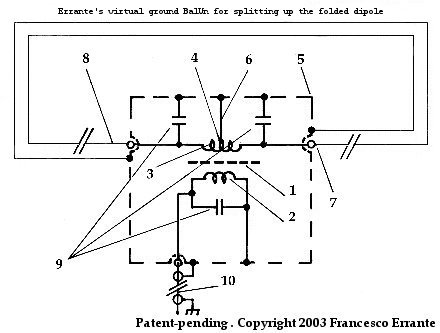
|
It is important to highlight the fact that the two
independently fed branches(7 & 8) can also be independently rotated
around their common axis to give a variable radiation pattern which
ranges from a typical dipole's radiation pattern, if the arms are
parallel to each other or a quasi-omnidirectional radiation pattern
in the case of the arms being placed perpendicularly to each-other
(turnstile
arrangement).
The balun described hereby is
characterized by being a NON
fluctuating impedance RF electrical transformer.
All of its terminations impedance values are set by design, hence the
impedance transformation ratio is a function of them and not
viceversa, unlike it happens with any other balun
arrangement.
|
Operational advantages:
|
a. the virtual ground balun allows the feeding of
dipole and loop antennas with much less loss than conventional
baluns
b. the virtual ground balun allows an aerial to exhibit a much larger
bandwidth compared to when the same antenna is fed by a conventional
balun.
c. the virtual ground balun allows an antenna to exhibit a much
stronger immunity to parasitic capacitive effects compared to when the
same antenna is fed by conventional baluns.
d. the virtual ground balun allows an antenna to exhibit a strong
resonance stability, regardless of the level and inclination of it
above the ground.
e. the virtual ground balun allows an antenna to exhibit a much
stronger immunity to out-of-band emissions compared to when the same
aerial is fed by a conventional balun.
f. the virtual ground balun allows an antenna to exhibit a much
stronger immunity to electrostatic charges and noises compared to when
it is fed by a conventional balun.
g. the virtual ground balun, owing to the constructive and destructive interference
phenomena taking place in the transformer allows the dipole antenna to exhibit a sharper
radiation/reception pattern (off the beam axis signal rejection) compared
to the same aerial when fed by a conventional balun.
h. the virtual ground balun allows a much faster antenna deployment
time compared to conventional baluns.
i. the virtual ground balun allows an antenna to exhibit a much better
compatibility with highly populated environments (EMC TVI) compared to
when it is fed by a conventional baluns.
|
Applications:
|
a. SHORT WAVES FIXED & MOBILE RADIO STATION FOR
CIVIL & MILITARY PURPOSES
b. STEALTH, FAST & TACTICAL DEPLOYMENT PURPOSES
c. SEARCH & RESCUE SERVICES
d. SHIP to SHIP & SHIP to SHORE MARINE COMMUNICATIONS
e. DX-ing and metropolitan HAM RADIO STATIONS
f. ELEMENT in ARRAYS of AERIALS
g. RADIO-PHYSICS LABORATORIES
see also SWR-metered
balun
|
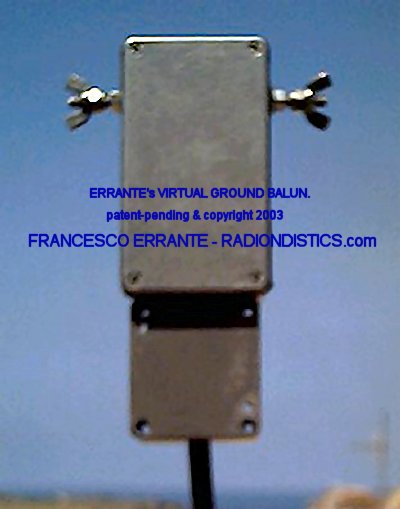
|
|
Errante's 50/70 Ohm virtual ground
balun
Freq. range: from 1 to 30 MHz
RF Power: 2KW CW
Click on the thumbnails to view larger
pictures
|
|
|
|
Schematic diagram of
Guanella's and Ruthroff's baluns
|
|
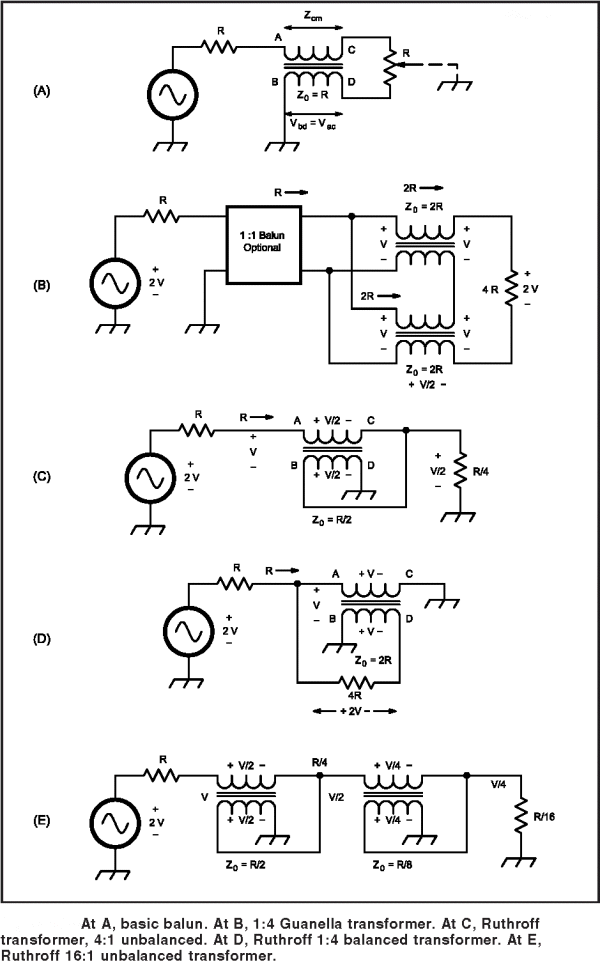
|
|
|
|
|
All the concepts, methods, designs and devices presented on this
web site
are the original novelty works of FRANCESCO ERRANTE.
Patents & Copyright © 1985- of FRANCESCO ERRANTE.
Material is governed by the Copyright, Designs and Patent Act.
No reproduction, in whole or in part, without written permission.
Copies of these documents made by electronic or mechanical means, including
information storage and retrieval systems, may only be employed for personal use.
All rights reserved.

|
All rights reserved. Copyright © 1985- Francesco Errante
www.Radiondistics.com - Tel.(+39) 339.180.1313
|
|





